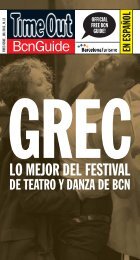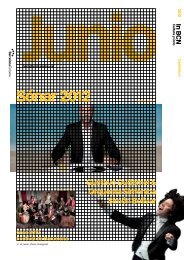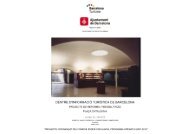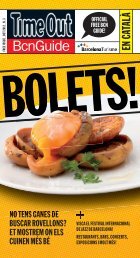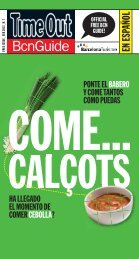You also want an ePaper? Increase the reach of your titles
YUMPU automatically turns print PDFs into web optimized ePapers that Google loves.
St Mary Magdalene,<br />
cap a l’any 1470<br />
Tempera on wood 144 x 73 cm<br />
JAUME HUGUET (1412 – 1492)<br />
Virginal she may not be, but with her worldly<br />
and direct gaze, Mary Magdalene is here<br />
painted as a lady of the royal court, with the<br />
attributes of the Virgin Mary. She sits on her<br />
throne, resplendent in the robes of a queen,<br />
holding a rosary, within a gilded frame with<br />
fine fluted columns in the purest Catalan<br />
Gothic style.<br />
The painting confers an air of regal<br />
mystery beyond that of her simple halo.<br />
The light around her face and smooth<br />
folds of her robes show the influence of<br />
Italian naturalism, while the meticulous<br />
detail draws on the Flemish tradition.<br />
The elegance, fragility and refinement<br />
of his work have earned Huguet a place<br />
as one of the greatest Catalan Gothic<br />
painters.<br />
FUNDACIÓ FRANCISCO GODIA<br />
Work acquired by Francisco Godia.<br />
ALSO NOT TO<br />
BE MISSED…<br />
The Spanish Wedding,<br />
1870<br />
MARIÀ FORTUNY (1838 – 1874)<br />
Though he died at 36, Fortuny is considered<br />
the greatest Spanish painter of<br />
the 19th century after Goya. The state<br />
funded his early studies in Rome, and<br />
commissioned large-scale paintings of<br />
the Spanish-Moroccan War of 1859. His<br />
travels in Northern Africa made a huge<br />
impact, turning him into one of Spain’s<br />
greatest Romantic painters of the<br />
Orient. After 1866 he turned to scenes<br />
of Spanish manners and customs, such<br />
as this one, set in a richly decorated<br />
18th-century sacristy.<br />
The Spanish Wedding shows off Fortuny’s<br />
technical virtuosity, his mastery<br />
of light and his fascination with costume<br />
and period details. Considered the<br />
finest example of his mature style, The<br />
Spanish Wedding catapulted its author<br />
to international fame.<br />
MNAC<br />
Acquired by public subscription in 1922.<br />
Cactus Man I, 1939<br />
JULI GONZÁLEZ (1876 - 1942)<br />
A starkly dissected body erupts into<br />
spikes, as World War II breaks out in<br />
Europe. Juli González was a leading<br />
figure in the Parisian avant-garde, and a<br />
pioneer of the use of welding and cutting<br />
techniques to create sculptures in iron.<br />
This fragmented figure, undergoing<br />
its symbolic metamorphosis, breaks<br />
with traditional ideas of symmetry,<br />
creating an interplay of contrasting<br />
forms and suggesting a new concept of<br />
volume. In González’ cubist investigations<br />
he sliced and folded sheet metal,<br />
using iron bars to ‘draw in space’ and<br />
create the wiry artworks that won him<br />
international fame.<br />
MNAC<br />
Donated by Roberta Gonzalez, the artist’s<br />
daughter, in 1972, and became part of<br />
the collection in 1973.<br />
12 Time Out BCN Guide <strong>November</strong> <strong>2012</strong>



